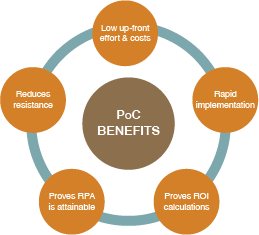Confessions of an ERP specialist: RPA is a quicker, easier solution
Change can be hard. Recognizing there's a need for change might be harder. An ERP specialist shares why RPA is a great solution that excels at “quick and easy.”
Reading time: 3 minutes

I have spent the majority of my career—more than 11 years—assessing, deploying, customizing, and training staff on a wide variety of new technology solutions. That includes many ERPs, as well as SCMs, CRMs, HCMs, LIMS and other “techy” acronyms.
The industries I worked with were just as diverse: manufacturing, warehousing and storage, research and development, distribution, information services, quality assurance, customer services, sales and marketing, healthcare and hospitals, and education, among others.
I’d like to think I’ve been effective. I like bringing order to chaos. I’ve loved my job and the people I’ve had the chance to work with. But after immersing myself in Robotic Process Automation (RPA), I have a confession. Large system implementation is the wrong approach for most organizations. RPA is a quicker, easier solution.
Picking on ERPs
I’m going to single out ERPs for my example, but the scenario is certainly not unique to an ERP implementation.
Issue 1. You have to spend a large chunk of money and time just to filter through a horde of options.
Issue 2. You’re forced to base your decision on cost—not the solution that fits your actual operational needs.
Issue 3. Your implementation partner is from a remote country; communication gaps are large.
Issue 4. Your implementation partner, from a remote country, doesn’t do business in the United States. They don’t know what a railcar is, or other basic business terms (i.e., liabilities, cash flow, etc.).
Issue 5. You will spend the maximum allotted budget—probably more—over the course of at least a year—but more often multiple.
The end product is often a highly customized, convoluted solution the majority of your staff resists and barely utilizes in a meaningful way. So, for all the frustration, unexpected and inexplicable overages, and time spent, you still don’t have the visibility you need into your operations.
And forget about when it becomes time for an update. You’re back at square one. Why? Because the customizations (probably not needed but pushed by your foreign partner) make updating just as costly and timely as the initial implementation. Your partner didn’t deliver on best practices, they just delivered what you asked—but poorly.
Farewell, frustration!
 Feeling familiar? Hitting too close to home?
Feeling familiar? Hitting too close to home?
While it may be too late for whatever implementation you spent time and dollars on in the past, I encourage you to read on to hear about my take on RPA and why it is different than every other technology solution out there. And here’s a tease: RPA does not replace the technology you have; RPA works with, enhances, and adds value to the technology you have.
What is RPA?
RPA stands for Robotic Process Automation. In short, it is a technology solution that uses programmed digital workers (aka ‘robots’ or, as I like to call them, ‘bots’) to mimic the work a human does—the routine, rules-based, time-consuming work. By letting a ‘bot do that work, you free up your human resources (more commonly referred to as your staff) to do more meaningful, thought-provoking work that adds real value.
Why RPA?

Not sure about RPA, engage us for a low-risk, low investment Proof of Concept (PoC).
I feel like that’s answered in the explanation of what it is and what it can do. But since most people like to see stats, here’s are some of the measurable benefits of RPA:
- Accelerated transformation. Among global executives, 63% say RPA is a major component in digital transformation.
- Major cost savings. RPA drives rapid, significant improvements to business metrics across industries and around the world.
- Greater resilience. RPA robots can ramp up quickly to match workload peaks and respond to big demand spikes.
- Higher accuracy. 57% of executives say RPA reduces manual errors.
- Improved compliance. 92% of executives agree RPA has “met or exceeded expectations” for better compliance.
- Boosted productivity. 68% of global workers believe automation will make them more productive.
- More innovation. 60% of executives agree RPA enables people to focus on more strategic work.
- Increased satisfaction. 57% of executives say RPA drives positive employee engagement.
So there it is. Now you know what RPA is and why it’s good for your organization.
If you want to see Garnet River’s two-month, six-step process to RPA implementation, you can download our implementation overview.


